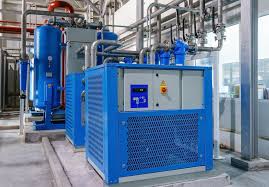-
Call
-
Whatsapp
9825014048
-
Location


Blog


BLOG

Right Refrigerated Air Dryer for Your Compressed Air System
At times, the removal of contaminants using compressed air treatment is overlooked. Specifying air quality as "clean and dry," "plant air," or "instrument quality air" is so common that specifications describing capacity, supply pressure, and site conditions are also often explicitly stated. More frequently than is healthy.
(Reference Link: https://www.measuremonitorcontrol.com/resources/measurement/iso-8573-air-purity ) The International Standard 8573-1 classifies air quality according to the concentration and size of particulates, moisture content, and oil purity. The air quality produced by a refrigerated compressed air drier typically satisfies class 4 standards: a pressure dew point of 38 degrees Fahrenheit or lower.
After determining if a refrigeration dryer would suffice and sizing it according to the compressor's capacity, you should be good to go when choosing a dryer. Wait a second! There are many more factors to consider when choosing and determining the size of a refrigerator dryer. Alternatively, thermal mass cycling or sizing up... When selecting an appropriate refrigerated air dryer for your compressed air system, the following is practically all the information you were unaware you needed to know.

Compressor Capacity and The Ambient Air Factor:
Sizing the compressed air dryer should be briefly considered before discussing different methods for chilled compressed air drying. The "three 100's"—inlet air temperature of 100 F, ambient temperature of 100 F, and inlet air pressure of 100 psig—are the usual ratings for compressed air dryers.
The capacity of the dryer varies as operating conditions differ from these conditions. As the temperature rises and the pressure falls, the capacity of air to retain moisture changes correspondingly. As the temperature increases and the pressure falls, the capacity of air to maintain moisture changes correspondingly. When the temperature outside rises, the chilled compressed air dryer has more difficulty dissipating the heat from the condenser into the air. How does a consumer choosing a compressed air dryer make sense of all this information?
First, we will review the circumstances of the incoming compressed air. You can about double the amount of moisture that air can carry for every 20 degrees Fahrenheit increase in temperature. Because there is less water to remove and the discharge temperature from an air-cooled air compressor can easily approach 120F in various conditions, the adequate capacity of the drier is improved with higher pressure.
On the other hand, air's capacity to retain moisture changes in the opposite direction of pressure. Higher pressure causes the intermolecular spaces to contract, making it harder for water vapour to remain a vapour. In its streamlined form, it materialises from thin air. Secondly, when the ambient temperature is high, the compressed air discharge temperature will also be high if the compressor is air-cooled. Consequently, the discussion of dryers is heavily dependent on ambient temperature.
Understanding Refrigerated Air Dryers:
Refrigerator Air Dryers extract water vapour from the air by lowering the compressed air temperature, thereby drying it out. This method reduces the air's dew point, protecting equipment and processes downstream from water damage.
Factors to Consider:
-
Flow Rate: Determine the volume of compressed air your system requires. Select a refrigerated dryer with a capacity that matches or exceeds this flow rate to ensure efficient moisture removal without impeding airflow.
-
Operating Pressure: Consider the pressure requirements of your compressed air system. Ensure the refrigerated air dryer can handle the operating pressure without compromising performance.
-
Dew Point: Different applications may require varying levels of dryness in the compressed air. Select a refrigerated air dryer with a dew point rating suitable for your needs. Lower dew points are necessary for sensitive applications such as pharmaceutical manufacturing or electronics production.
-
Energy Efficiency: Look for energy-efficient models to minimise operating costs over the long term. Compressors with variable speeds and thermal mass storage are two features that can drastically cut power usage without sacrificing performance.
-
Size and Installation: (B) Consider the available space for installation and the refrigerated air dryer's compatibility with your existing compressed air system. Ensure adequate ventilation and access for maintenance.
-
Maintenance Requirements: Regular maintenance is essential for your refrigerated air dryer's continued efficiency and reliability with your existing compressed air system. Ensure adequate ventilation and access for maintenance.
-
Maintenance Requirements: The chilled air dryer must be maintained regularly. Choose a model with accessible components and clear maintenance instructions for simple upkeep.
-
Budget: Although money is a significant consideration, prioritize performance and quality over immediate cost reductions. You could save much money on maintenance and downtime by purchasing a dependable chilled air dryer.


FAQs

Frequently Ask Questions
As the air is cooled in a refrigerated air dryer, any moisture in the air is forced to condense and eventually escape. This process lowers the dew point, ensuring that downstream equipment and processes receive dry, clean air, thus preventing damage and corrosion.
Consider factors such as flow rate, operating pressure, and desired dew point. Match the dryer's capacity to your system's airflow requirements while ensuring it can handle the operating pressure without compromising performance.
The dew point indicates the dryness achieved by the air dryer. Different applications may require varying dew point levels. Sensitive industries like pharmaceutical manufacturing or electronics production typically require lower dew points to maintain product quality and integrity.
Look for energy-efficient models with variable speed compressors and thermal mass storage features. These technologies minimize power consumption while maintaining optimal performance, resulting in long-term cost savings.
Regular maintenance is crucial for a refrigerated air dryer's continued efficiency and reliability. Choose a model with accessible components and clear maintenance instructions. Ensure proper ventilation and access for maintenance tasks to uphold the dryer's performance over time.
